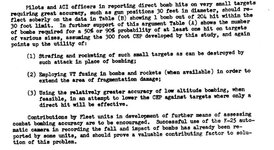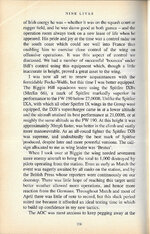Spitfire pilot on the subject:
Increasing evidence began to accumulate that Hitler's threat of devastating secret weapons was not an idle one. Along the French, Belgian and Dutch coasts the Germans were building rectangular cement ramps, and they were all pointed at London. Intense aerial surveillance by our PRU aircraft indicated that these structures were designed to launch something. A technique was devised to use Spitfires as dive bombers, and a directive describing it was sent out.
The target was to be approached at eight thousand feet. When it was opposite the wing tip, the aircraft was to be turned and dived at an angle of sixty degrees holding the bead of the gun-sight on the target. At three thousand feet a gradual pull-out was to be executed and on the count of three, the bomb dropped. As a footnote to the instructions, a word of caution was included. The bomb should not be released in the dive, only in the pull-out, lest it should hit the prop and blow you all to hell. Norm Fowlow, one of my former pilots in the Wolf Squadron was given command of a squadron of his own. While leading his men on a dive-bombing attack on the launching pads, his aircraft was seen to disintegrate. It was assumed that his bomb must have hit the prop.
It wasn't long before we discovered that this technique of dive bombing was extremely inaccurate. One could only take a guess at what was a sixty-degree dive. Without dive brakes, Spitfires dived so fast that the hands of the altimeter went around in a blur. Pulling out at exactly three thousand feet with the use of an instrument that lagged was impossible.
Squadrons went out individually, twelve aircraft at a time. I took my turn leading these sorties, and on one occasion I led my old outfit. I was told to bring the bombs back if I found the target obscured by cloud. The tail of the bomb was approximately an inch from the ground on takeoff or landing. In spite of the experts' assurance that the bomb would not explode unless the arming switch had been pressed, none of the pilots were anxious to see what would happen if it fell off. I dutifully read this order with tongue in cheek. I hadn't the slightest intention of bringing the bombs back.
As we approached the target twenty miles away, I could see that it was obscured by a cloud. We were flying up the Somme, and we were welcomed by a furious barrage of heavy flak. Looking down, I saw a large round heavy gun emplacement emitting a series of flashes from its eighty-eight millimetre gun.
'Echelon port!'
Instantly the Squadron slid underneath me and stationed themselves on my port wing.
'Press arming switches and prepare to attack!'
When the bunker was opposite my starboard wingtip, I rolled over and went straight down. There was nothing I could think that deserved a bombing more than a flak battery. I pulled out as close as I could to three thousand feet and on the count of three dropped the bomb. When I cocked my starboard wing up, I was just in time to see my bomb explode in the centre of the bunker. The rest of the Squadron's bombs hit all around it. The flak ceased. I ordered the Squadron to regroup and was relieved to count twelve aircraft. As we flew home, a voice on the R/T/ said:
'Sheer unadulterated bullshit luck, Skipper!'
I maintained a discreet silence.
Increasing evidence began to accumulate that Hitler's threat of devastating secret weapons was not an idle one. Along the French, Belgian and Dutch coasts the Germans were building rectangular cement ramps, and they were all pointed at London. Intense aerial surveillance by our PRU aircraft indicated that these structures were designed to launch something. A technique was devised to use Spitfires as dive bombers, and a directive describing it was sent out.
The target was to be approached at eight thousand feet. When it was opposite the wing tip, the aircraft was to be turned and dived at an angle of sixty degrees holding the bead of the gun-sight on the target. At three thousand feet a gradual pull-out was to be executed and on the count of three, the bomb dropped. As a footnote to the instructions, a word of caution was included. The bomb should not be released in the dive, only in the pull-out, lest it should hit the prop and blow you all to hell. Norm Fowlow, one of my former pilots in the Wolf Squadron was given command of a squadron of his own. While leading his men on a dive-bombing attack on the launching pads, his aircraft was seen to disintegrate. It was assumed that his bomb must have hit the prop.
It wasn't long before we discovered that this technique of dive bombing was extremely inaccurate. One could only take a guess at what was a sixty-degree dive. Without dive brakes, Spitfires dived so fast that the hands of the altimeter went around in a blur. Pulling out at exactly three thousand feet with the use of an instrument that lagged was impossible.
Squadrons went out individually, twelve aircraft at a time. I took my turn leading these sorties, and on one occasion I led my old outfit. I was told to bring the bombs back if I found the target obscured by cloud. The tail of the bomb was approximately an inch from the ground on takeoff or landing. In spite of the experts' assurance that the bomb would not explode unless the arming switch had been pressed, none of the pilots were anxious to see what would happen if it fell off. I dutifully read this order with tongue in cheek. I hadn't the slightest intention of bringing the bombs back.
As we approached the target twenty miles away, I could see that it was obscured by a cloud. We were flying up the Somme, and we were welcomed by a furious barrage of heavy flak. Looking down, I saw a large round heavy gun emplacement emitting a series of flashes from its eighty-eight millimetre gun.
'Echelon port!'
Instantly the Squadron slid underneath me and stationed themselves on my port wing.
'Press arming switches and prepare to attack!'
When the bunker was opposite my starboard wingtip, I rolled over and went straight down. There was nothing I could think that deserved a bombing more than a flak battery. I pulled out as close as I could to three thousand feet and on the count of three dropped the bomb. When I cocked my starboard wing up, I was just in time to see my bomb explode in the centre of the bunker. The rest of the Squadron's bombs hit all around it. The flak ceased. I ordered the Squadron to regroup and was relieved to count twelve aircraft. As we flew home, a voice on the R/T/ said:
'Sheer unadulterated bullshit luck, Skipper!'
I maintained a discreet silence.


